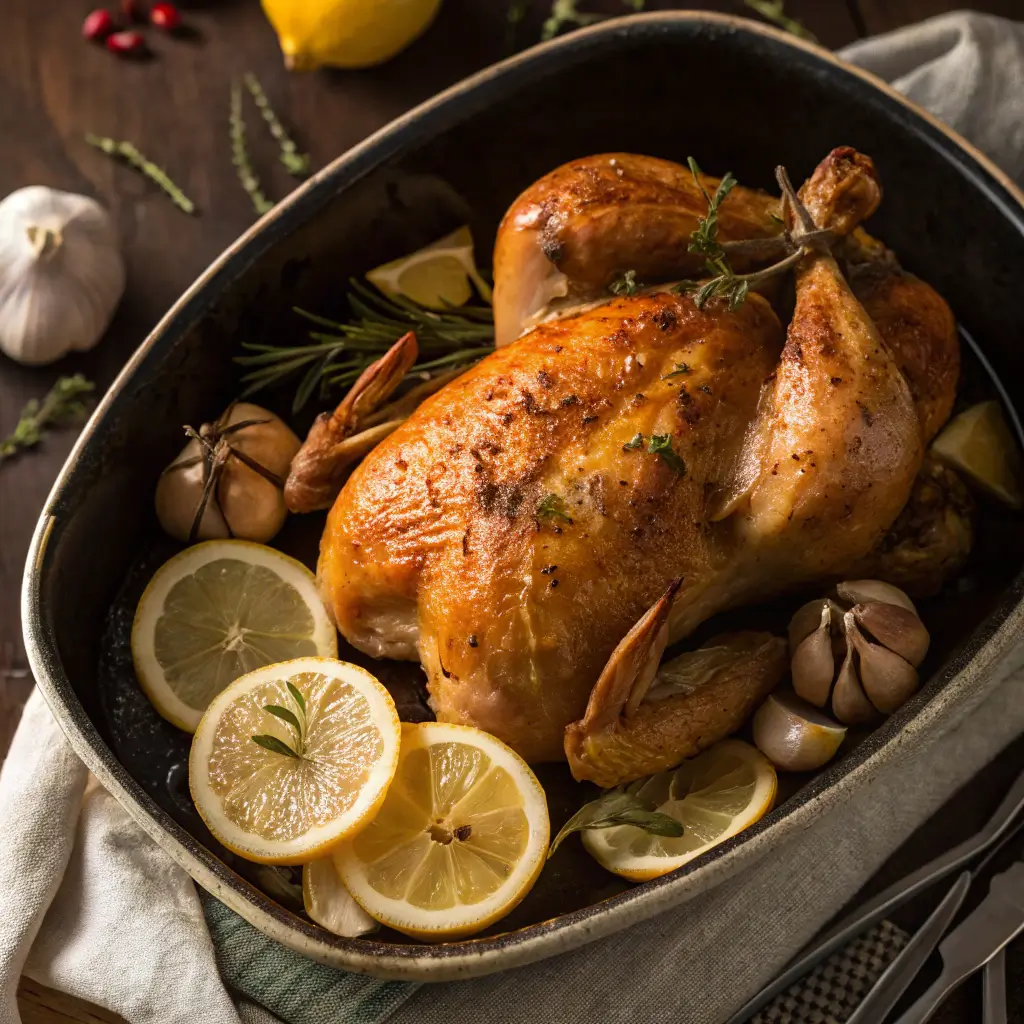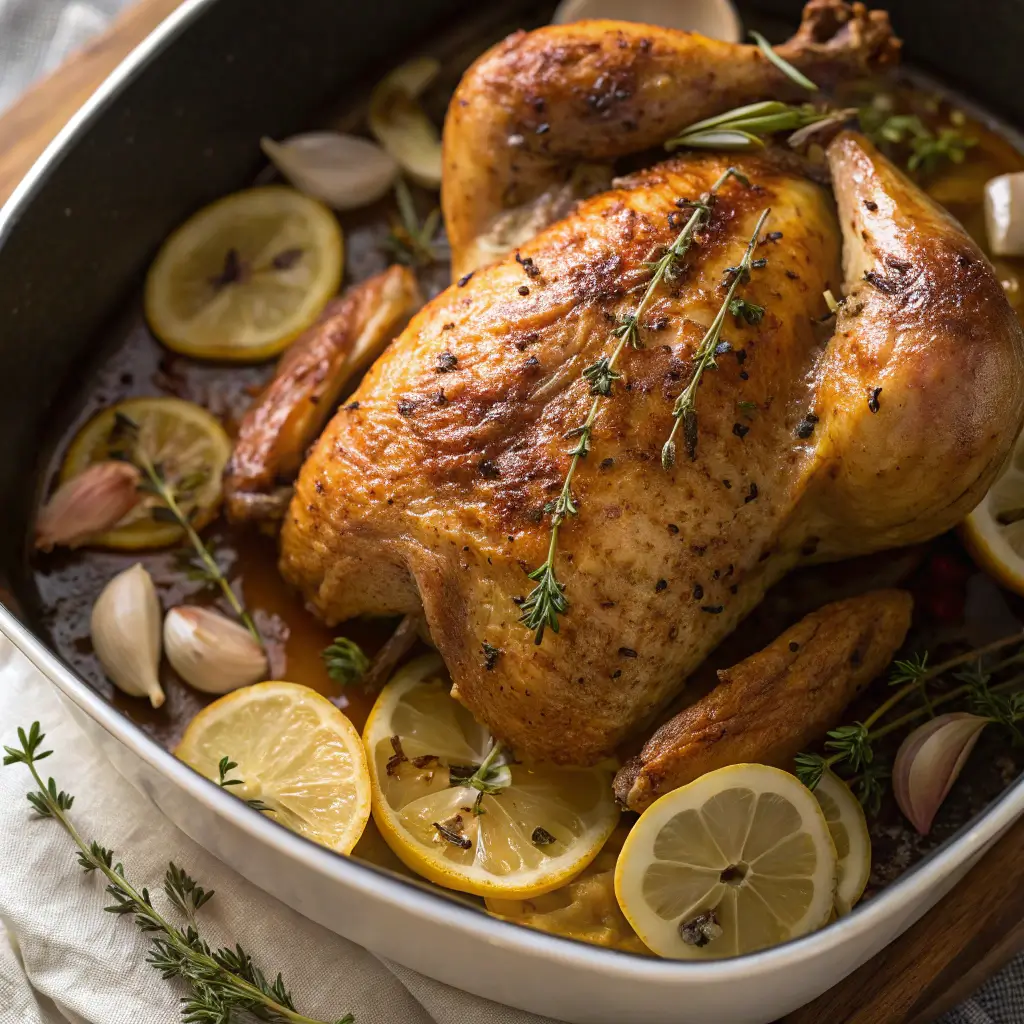Roast Chicken with Lemon and Garlic: The Ultimate Comfort Classic
Introduction
Few recipes embody the warmth of home cooking as well as a golden, juicy roast chicken. It’s a dish that feels both rustic and elegant, making it suitable for Sunday family dinners or festive gatherings with friends. The aroma of garlic and lemon mingling with roasting chicken is enough to draw everyone into the kitchen.
Roast Chicken with Lemon and Garlic is a timeless recipe that never goes out of style. It’s simple, budget-friendly, and yields a dish that’s both hearty and refreshing. The lemon brightens the flavors, garlic adds depth, and herbs tie everything together. It’s a recipe that teaches us how much can be achieved with a handful of wholesome ingredients and a little patience.
This article will guide you step by step, offering practical tips, expert troubleshooting, creative variations, and serving ideas so you can master this recipe and enjoy it again and again.

A Bit of History and Cultural Significance
Roasting poultry dates back centuries and has deep roots in cuisines across the world. In many European traditions, roast chicken was considered a centerpiece dish for celebrations. The French are famous for their simple roast chicken, often seasoned only with herbs and lemon. In Mediterranean cooking, citrus and garlic are essential pairings with poultry, balancing richness with brightness.
Across cultures, a roasted bird symbolizes abundance and hospitality. A whole chicken, shared at the table, encourages family-style dining and connection. This recipe is not only about flavor but also about tradition—one that continues to bring comfort to modern kitchens.
Why You’ll Love This Recipe
- Crispy skin, juicy meat: The high-heat roasting method ensures perfect texture.
- Minimal ingredients, maximum flavor: Simple pantry staples elevate the dish.
- Healthy and nourishing: Packed with protein, vitamins, and antioxidants.
- Versatile: Perfect as a centerpiece dish or as leftovers in soups, salads, or sandwiches.
- Beginner-friendly: No complicated techniques, just classic roasting made easy.
Ingredients
For the Chicken
- 1 whole chicken (4–5 lbs / 1.8–2.2 kg)
- 2 lemons (1 halved, 1 sliced into rings)
- 1 garlic bulb, halved horizontally
- 3–4 tablespoons olive oil or melted butter
- 1 teaspoon sea salt
- ½ teaspoon freshly ground black pepper
- 3–4 sprigs fresh thyme or rosemary
For the Roasting Base
- 1 onion, quartered
- 2 carrots, cut into large chunks
- 2 celery stalks, cut into large chunks
Garnish (Optional)
- Fresh parsley, chopped
- Extra lemon wedges for squeezing
Equipment
- Roasting pan or oven-safe skillet
- Meat thermometer
- Kitchen twine (optional, for trussing)
- Sharp carving knife
Step-by-Step Instructions
1. Preparing the Chicken
Take the chicken out of the refrigerator about 30 minutes before roasting to allow it to come to room temperature. This helps it cook evenly. Pat the skin thoroughly dry with paper towels. Removing excess moisture is key to crisping the skin.
2. Seasoning Inside and Out
Rub the chicken all over with olive oil or butter. Sprinkle with salt and pepper, making sure to season the cavity as well. Stuff the cavity with half a lemon, half a garlic bulb, and a couple of sprigs of thyme or rosemary.
3. Creating the Flavor Base
Spread the onion, carrots, celery, and remaining garlic in the roasting pan. Place the lemon slices on top. These vegetables act as a rack for the chicken, while also absorbing delicious drippings you can use for a sauce later.
4. Roasting the Chicken
Preheat the oven to 425°F (220°C). Place the chicken breast-side up on top of the vegetables. Roast for 20 minutes at this high temperature to develop crisp skin. Then, lower the temperature to 375°F (190°C) and continue roasting for about 1 hour, depending on the size of the bird.
Check doneness with a meat thermometer: the thickest part of the thigh should register 165°F (74°C).
5. Resting the Bird
Transfer the chicken to a cutting board and cover loosely with foil. Let it rest for 10–15 minutes before carving. Resting allows the juices to redistribute, ensuring moist and tender meat.
6. Carving and Serving
Carve the chicken by removing the legs, thighs, wings, and breasts. Arrange on a platter with roasted vegetables and garnish with fresh parsley and lemon wedges.
Expert Tips & Troubleshooting
- Skin not crisping? Make sure the chicken is completely dry before roasting and start at high heat.
- Breast meat too dry? Try covering the breast loosely with foil during the final 20 minutes.
- Want more flavor? Loosen the skin gently and spread herb butter directly underneath.
- Uneven cooking? Trussing helps but isn’t essential—just make sure the bird is breast-side up.
Flavor Variations
- Herb Lovers’ Roast: Add sage, oregano, or marjoram along with thyme.
- Garlic Lovers’ Version: Use two bulbs of garlic, spreading cloves under the skin for extra punch.
- Citrus Twist: Swap lemon for orange or a mix of lemon and lime for a different brightness.
- Spicy Roast Chicken: Rub the skin with paprika, cayenne, or chili flakes for a subtle kick.
Serving & Presentation Ideas
- Weeknight Dinner: Pair with roasted potatoes and steamed broccoli.
- Elegant Meal: Serve with risotto or creamy mashed potatoes.
- Light Option: Slice the chicken over a fresh green salad with vinaigrette.
- Family Style: Place the whole bird on the table surrounded by roasted vegetables for a stunning centerpiece.
Storage & Make-Ahead Tips
- Refrigeration: Store in an airtight container for up to 4 days.
- Freezing: Freeze shredded chicken in freezer bags for up to 3 months.
- Reheating: Warm in the oven at 325°F (160°C) or gently in the microwave with a splash of broth to prevent drying.
- Make-ahead option: Season the chicken, cover, and refrigerate overnight. Roast the next day for enhanced flavor.
Nutritional Highlights
- Protein: Chicken is an excellent source of lean protein.
- Garlic: Offers immune-boosting compounds.
- Lemon: Adds vitamin C for immunity and brightness.
- Herbs: Provide antioxidants and natural flavor without added fat.

Frequently Asked Questions
Q: Can I roast the chicken with potatoes in the same pan?
Yes. Add small potatoes around the bird about 30 minutes before the chicken is done so they roast in the juices.
Q: What if I don’t have fresh herbs?
Dried thyme or rosemary works well. Use about 1 teaspoon dried for every tablespoon fresh.
Q: How do I know when the chicken is fully cooked?
Always use a thermometer. Insert into the thickest part of the thigh without touching the bone—it should read 165°F (74°C).
Why This Recipe Stands Out
This recipe highlights the power of simplicity. Lemon, garlic, and fresh herbs elevate the natural flavor of chicken without overpowering it. The roasting method is forgiving yet produces restaurant-quality results. Whether you’re a beginner or a seasoned cook, this dish offers both reliability and versatility.
Conclusion
A Roast Chicken with Lemon and Garlic is more than just dinner—it’s an experience of comfort, tradition, and flavor. With its crispy skin, juicy meat, and aromatic flavors, it’s a dish that can be served proudly on any occasion.
The next time you’re looking for a meal that’s both impressive and approachable, reach for this recipe. Roast it for your family on a weeknight, or bring it to the table at your next celebration. Either way, it’s a recipe that’s bound to become a staple in your kitchen.
